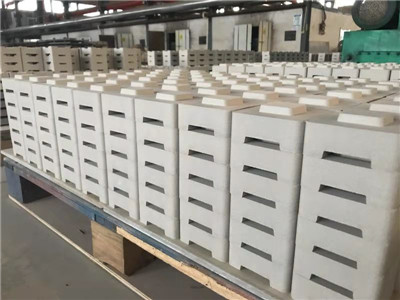Application of Cordierite Mullite in Kiln Furniture
The cordierite matrix in cordierite-mullite kiln furniture endows the refractory with a low coefficient of thermal expansion and good thermal shock resistance. The low-aluminum mullite particles in the cordierite-mullite kiln furniture endow the material with a certain high-temperature resistance and volume stability under thermal conditions. Cordierite-mullite only contains oxides with stable valence, which will not pollute ceramic products due to oxidation-reduction problems. Therefore, cordierite-mullite refractory materials are often used to make refractory products such as shed plates, backing plates, and supports of ceramic kilns. What are the characteristics of cordierite-mullite kiln furniture?

Cordierite Mullite Kiln Furniture
Primary kiln furniture refers to refractory products such as shed slabs and pillars for building the firing space. Secondary kiln furniture refers to the small kiln furniture placed on the primary kiln furniture directly used to support or protect the products to be fired. In addition to primary kiln furniture, cordierite-mullite materials include secondary kiln furniture of various complexities and shapes.
Application of Cordierite Mullite in Kiln Furniture
Cordierite-mullite has good high-temperature properties such as thermal expansion and thermal shock stability. Cordierite-mullite composites are widely used.
Kiln furniture is a special-shaped refractory material that supports and protects the firing process of ceramic products and magnetic materials. It has an extremely important impact on the quality of ceramic products and the energy consumption of the ceramic industry, mainly including saggars, shed plates, pad cakes, columns, and push plates. The performance of kiln furniture directly affects the quality and production cost of fired objects such as ceramics. General kiln furniture materials should have the following basic properties: high refractoriness, good thermal shock resistance, and chemical stability; high strength at room temperature and high temperature. Because one of the functions of kiln furniture is to bear the load, it must withstand the load of the product and the kiln furniture itself. High-strength kiln furniture materials can make kiln furniture light and thin, so as to increase the density of the kiln and improve the quality of products. In addition, it is also required to have good thermal conductivity and low thermal storage, regular appearance, and precise dimensions.
The cordierite material has the characteristics of a small thermal expansion coefficient and excellent thermal shock resistance and is widely used in ceramic kiln furniture by domestic and foreign manufacturers. The thermal shock resistance of kiln furniture is a key parameter that determines the life of kiln furniture. When the main material is determined, the thermal shock resistance of kiln furniture must be improved from its microstructure. So that it has high elastic modulus, fracture surface energy and thermal conductivity, low thermal expansion coefficient, and so on. Improved thermal shock resistance can be achieved by reducing thermal stress caused by thermal expansion, forming microcrack networks, and introducing energy dissipation mechanisms during inter-particle interface fracture. The thermal shock resistance of cordierite kiln furniture can be further improved by doping andalusite to introduce the energy dissipation mechanism during interface fracture.
Although cordierite has a small thermal expansion coefficient and good thermal stability, it has a low softening temperature under load and a small operating temperature range. Although products such as mullite and silicon carbide have good high-temperature performance, their cost is high. Using the mullite effect of andalusite at high temperatures, by adding SiC and a small amount of artificial mullite, the organizational structure of cordierite ceramic kiln furniture materials can be significantly changed. Improve high-temperature performance and reduce the cost of kiln furniture materials. Cordierite and cordierite-mullite kiln furniture structure is a ring-shaped silicate. Since the tetrahedrons in the structure are connected into a special helical six-membered ring, there are large gaps in the structure. When the particle is heated, it can vibrate to the gap, so the cordierite kiln has the characteristics of a small thermal expansion coefficient and excellent thermal shock resistance. However, cordierite is an unstable compound that decomposes into mullite and glassy phases. And the firing temperature range is narrow, and the high-temperature performance is poor. The mullite material has high refractoriness and good high-temperature stability. The mismatch between the thermal expansion coefficients of cordierite and mullite results in the formation of micro-cracks at the two-phase interface, which makes the material have excellent thermal shock resistance and good high-temperature performance. Therefore, cordierite-mullite composite materials are widely used in high-grade ceramic kiln furniture at home and abroad.
With the transformation of the firing technology of the ceramic industry from the traditional saggar firing to the open flame saggarless firing technology, the demand for high-quality ceramic kiln furniture materials – shed slabs is increasing. As one of the special kiln furniture for supporting porcelain pieces shed plate has always been an important auxiliary material in the ceramic industry. The material is mostly cordierite-mullite composite material with good thermal shock resistance and high-temperature performance. The cordierite-mullite slab is sintered from mullite and cordierite. The mechanism is that cordierite has a much smaller thermal expansion coefficient than mullite due to the large voids in the ring structure of cordierite. The expansion coefficients of the two are matched, so that micro-cracks are formed at the interface of the two phases, preventing the propagation of destructive cracks. Thereby, the thermal stability performance of the cordierite-mullite shed plate is greatly improved.
High alumina refractory products containing cordierite, it is made of high alumina raw material, synthetic cordierite, and binder. The thermal shock stability of the product is very good, and it can be used as ceramic kiln furniture, heat exchanger, catalyst carrier (honeycomb ceramic) for purifying waste gas, etc. For a free quote on cordierite bricks, please contact us.